The degree of income elasticity of demand for different types of goods is different. So, it is imperative to quantity the income elasticity of demand for the business decision as well as other policy-related decisions. Economists have suggested different methods to compute the income elasticity of demand. The following are the major methods used in the measurement of income elasticity of demand.
- Percentage or Proportion Method
- Point Method or Geometric Method
- Arc Method
The following section includes a short explanation of all the methods of measurement of income elasticity of demand.
Contents
Percentage or Proportion Method
Under percentage or proportion method, income elasticity of demand can be measured with the help of following formula;
EY= (Percentage change in quantity demanded/Percentage change in income) = %∆Qd/%∆Y
Or, EY= (∆Q/Q) *100/(∆Y/Y) *100
Or, EY= (∆Q/∆Y) *(Y/Q)
Where,
Where EY= Income elasticity of demand; ∆Q= Change in quantity demanded; Q= Original quantity demanded; Y= Original Income; and ∆Y= Change in Income
Arc/Average/Mid-Way/Mid-Point Method
When there is a larger change in income and quantity demand then arc, the method is suitable to calculate income elasticity of demand. This method measures income elasticity of demand between two points on the same demand curve. The area between two points on a non-linear demand curve is the arc. Thus, this method is appropriate to apply to measure the income elasticity of demand over an arc of a nonlinear demand curve.
The following formula is needed to calculate the coefficient of income elasticity of demand under the arc method.
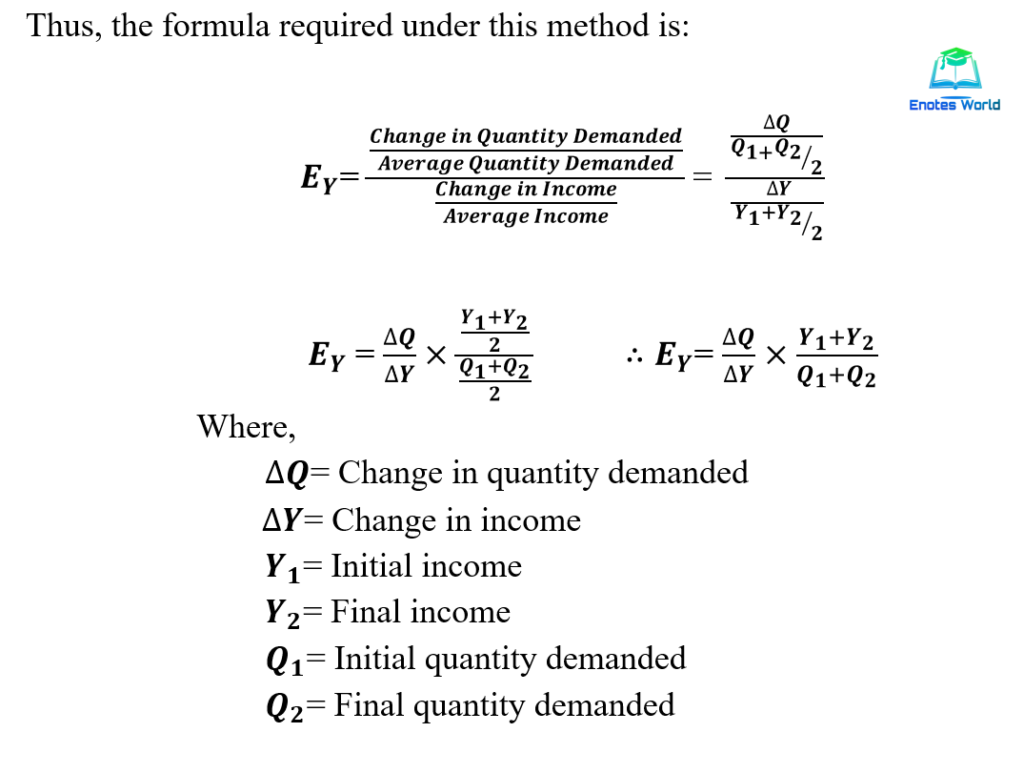
The following figure shows the measurement of income elasticity of demand by the arc method.
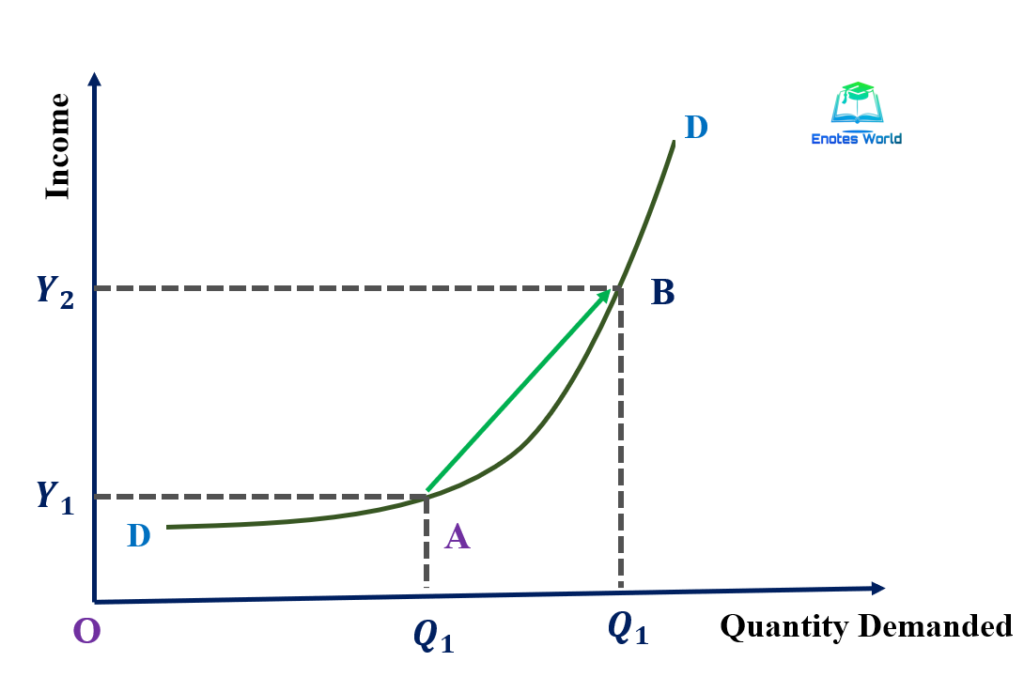
In the above figure, DD is the non-linear demand curve. AB is an arc on the upward sloping income demand curve. The arc method measures the income elasticity at the average of income-demand combination A and B by using the above formula.
Point Method
The method of measuring elasticity of demand at a finite point on a given demand curve is known as the point method. When there is a very small change in income and quantity demand then we have to use point method of measurement of income elasticity of demand. Generally, there are two types of income demand curve as linear and non-linear. The following section presents a description of the measurement of income elasticity of demand under point method on a linear demand curve and non-linear demand curve.
Income Elasticity of Demand under Point Method on a Linear Demand Curve
The income demand curve displays the positive relationship between income and quantity demand. In the case of an inferior good, this relation will turn into a negative one. Similarly, the linear demand curve deals with such a demand curve that has a similar slope at every point of it. Here we will discuss the measurement of income elasticity of demand under point method at a given point on positively sloping income demand curve. The following figure helps us to determine the income elasticity of demand under point method.
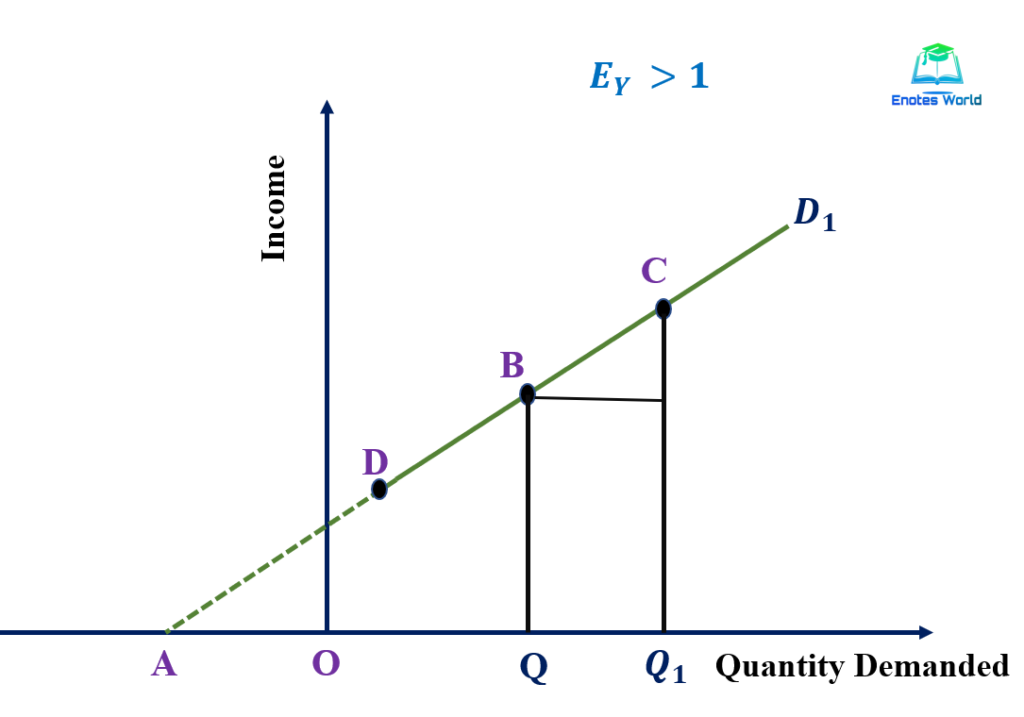
In the given figure DD1 is the upward sloping income demand curve to the right. Suppose we want to measure the income elasticity of demand at point B. For the measurement of income elasticity of demand by point method at point B.
Here,
Initial income (Y1) = BQ; new income (Y2) = CQ1; so, change in income (∆Y) = CE
Initial demand (Q1) = OQ; new demand (Q2) = OQ1; so, change in demand (∆Q) = OQ1 or BE
Now extending the income demand curve DD1 downward to meet X-axis at point ‘A’.
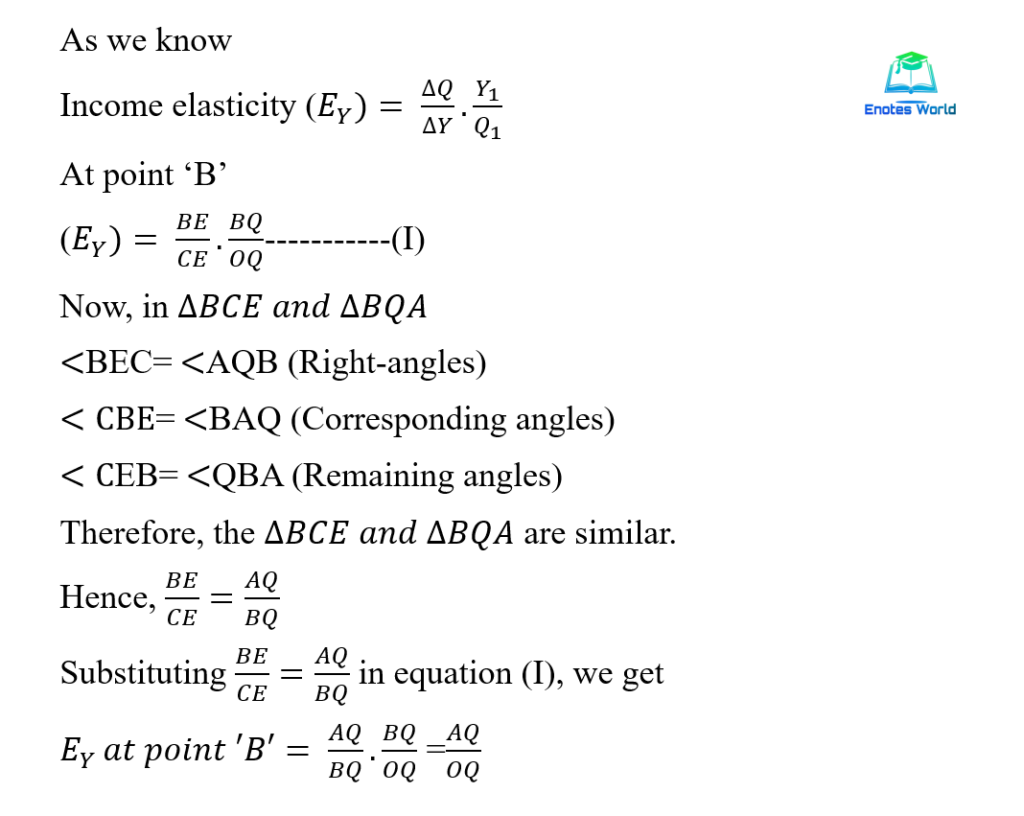
Thus, income elasticity at point B can be obtained by measuring AQ and OQ and dividing AQ by OQ. As per the figure, AQ is greater than OQ. Thus, the income elasticity of demand at point ‘B’ is greater than one (EY>0). Therefore, the overall calculation can be concluded as;
- If the extended income demand curve meets the X-axis left to the origin, the income elasticity of demand is greater than one. It means if the extended income demand curve intersects Y-axis then it is the case of income elasticity is greater than one or elastic income demand curve. (EY>0).
- If the extended income demand curve passes through origin or if it meets the x-axis to the part of origin then the income elasticity of demand will be equal to one or unitary elastic income demand. The following figure shows the case on the unitary income elastic demand curve. (EY =1).

- If the extended demand curve meets X-axis right to the origin or if the income demand curve intersects X-axis with its extension then income elasticity is less than one or it is the case of the inelastic income demand curve. (EY < 1). The following figure shows the case of the inelastic income demand curve.
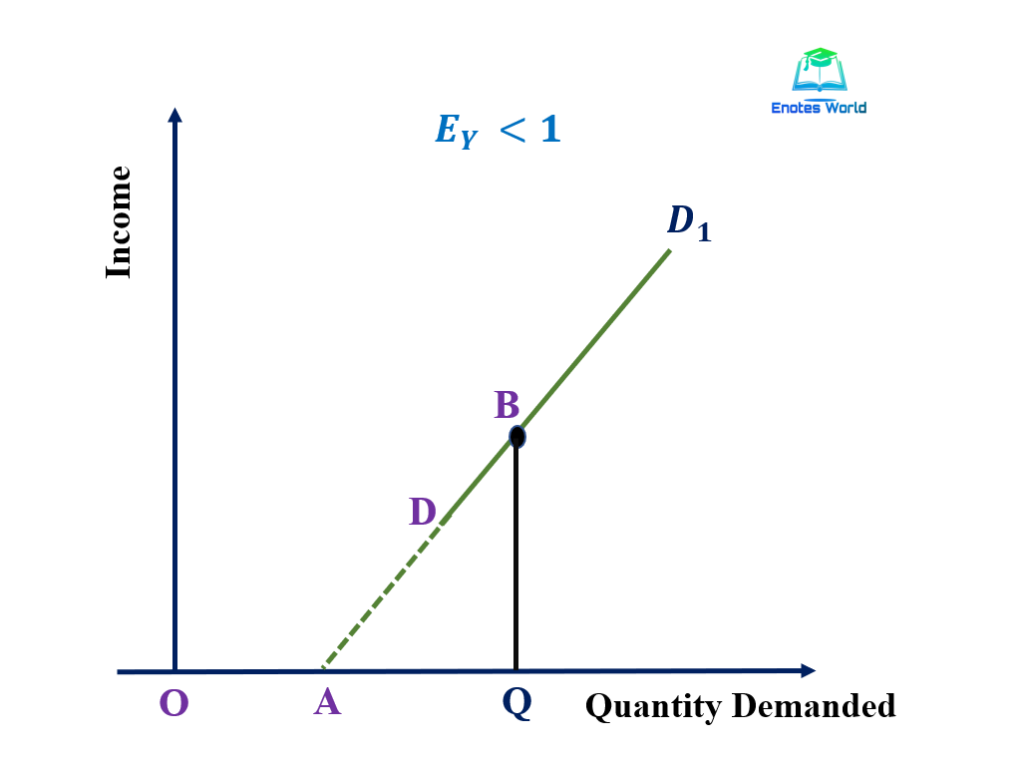
Income Elasticity of Demand under Point Method on a Non-linear Demand Curve
The demand curve is non-linear when the slope of the demand curve changes along the same demand curve. If the demand curve is non-linear then the income elasticity of demand at a particular point can be measured by drawing a starlight line that is tangent to the point of the non-linear demand curve. After drawing the tangent line, we can apply the same procedure as a linear demand curve.
The following figure shows the measurement of income elasticity of demand under point method at a point on the non-linear demand curve.
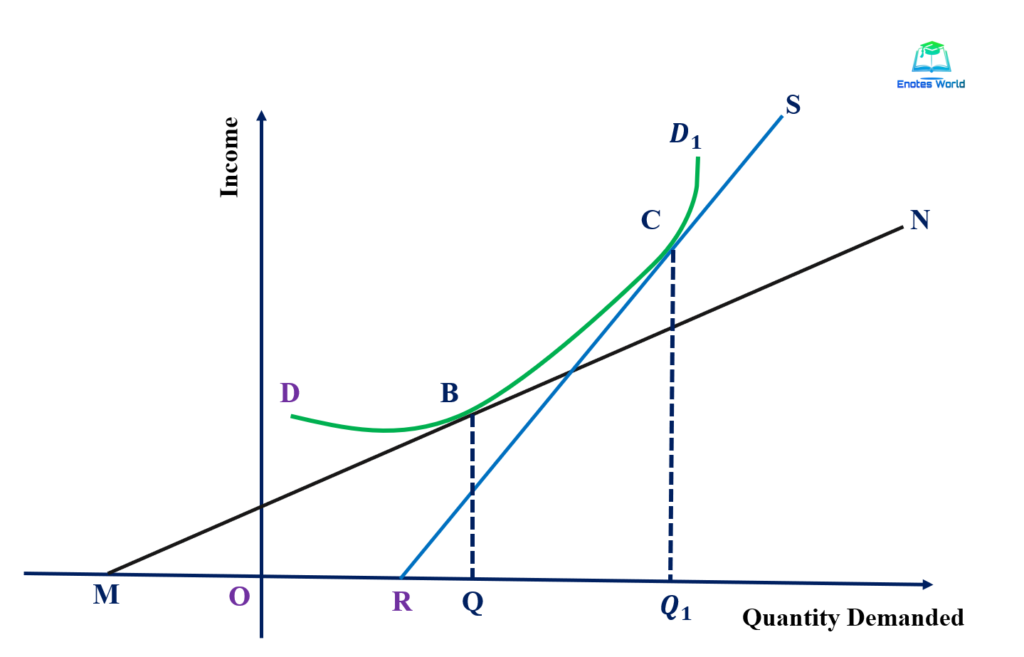
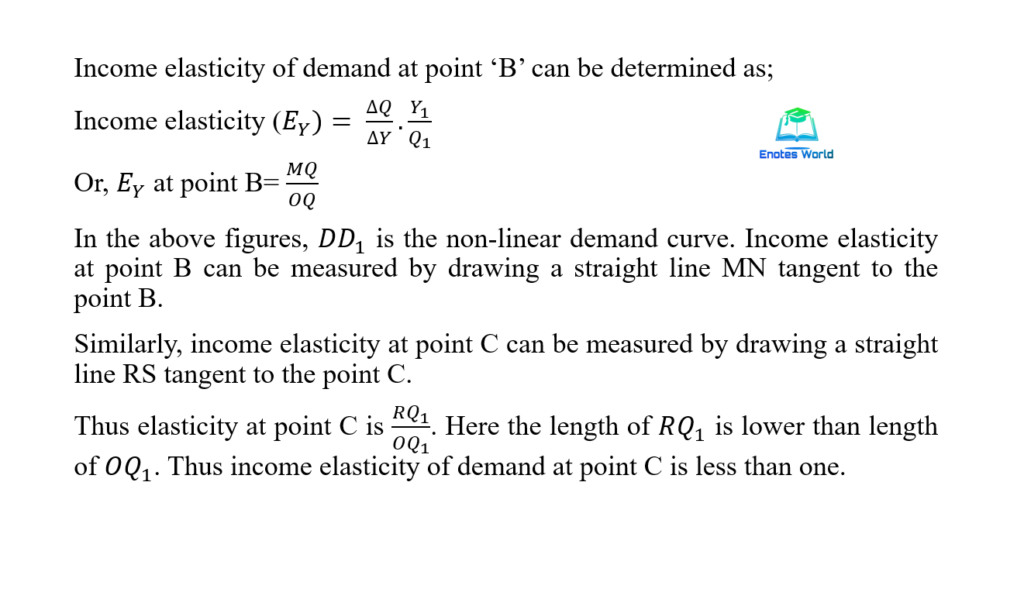
References and Suggested Readings
Adhikari, G.M. and et.al. (2019). Microeconomics for Business. Kathmandu: KEC Publication
Dhakal, R. (2019). Microeconomics for Business. Kathmandu: Samjhana Publication Pvt. Ltd.
Mankiw, N.G. (2009). Principles of Microeconomics. New Delhi: Centage Learning India Private Limited
Salvatore, Dominick. (2003). Microeconomics: Theory and Application. Oxford University Press, Inc.
Shrestha, P.P. and et.al. (2019). Microeconomics for Business. Kathmandu: Advance Sarswati Prakashan.